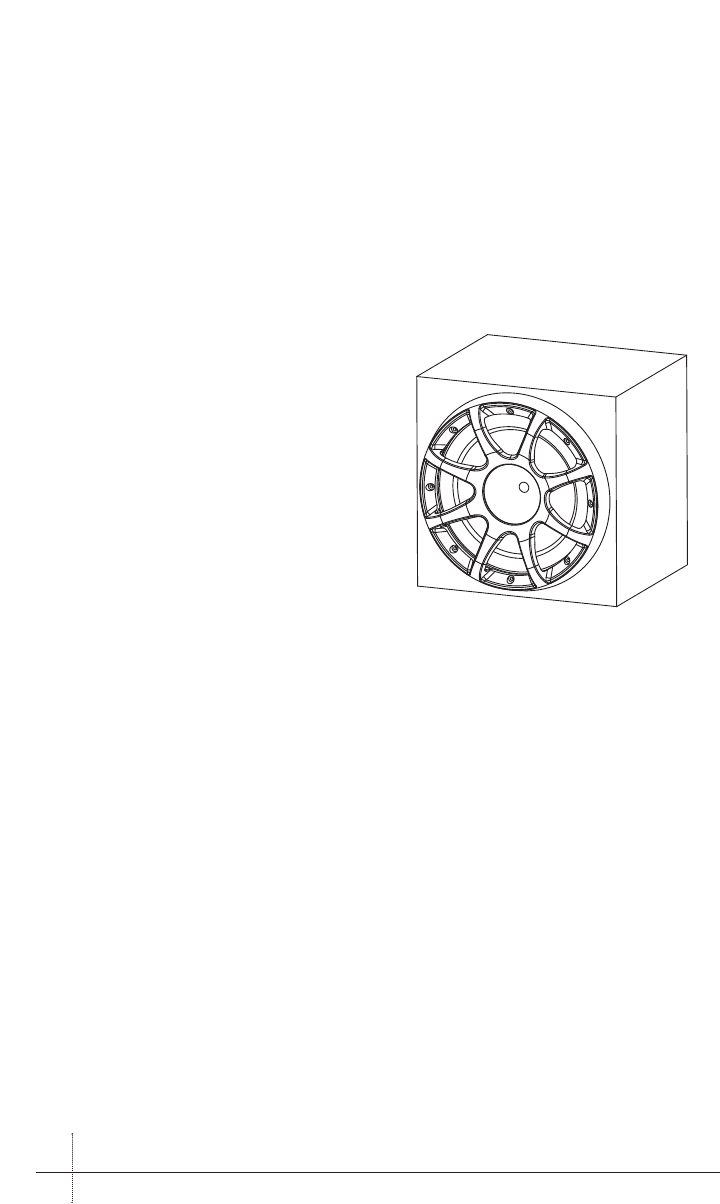
6
POLK/MOMO: CHAMPIONSHIP PERFORMANCE
6
POLK/MOMO: CHAMPIONSHIP PERFORMANCE
Building an Enclosure for MM Series
Who Is Going To Build Your Subwoofer
Enclosure?
Since the subwoofer enclosure is so critical to getting the
best performance from your Polk/MOMO subs, you should
ask yourself the following questions:
1. Do I really enjoy working with my hands?
2. Do I have good woodworking and mechanical skills?
3. Do I have, or have access to, woodworking
and electrical tools?
4. Do I have a solid understanding about musical
reproduction in an automobile?
• If you answered NO to any of the above questions, we
recommend you choose one of these two possible alter-
natives: First, there are pre-built subwoofer enclosures
on the market from manufacturers like Q-Logic and R/T,
or enclosure kits from BassLine and others. The second
alternative is to have your authorized Polk Audio dealer
design and build a woofer box for you.
• If you answered YES to all of the above, let’s review
some basics before you begin.
Building Your Own Enclosure
The Polk/MOMO subwoofers have been optimized to give
you flat bass response in small sealed enclosures. Some lis-
teners may want response other than “flat,” or may want to
trade-off depth of response for greater efficiency by using a
vented enclosure. There is no way we could provide all the
information for all of the options here. This manual will give
you enough information to build a great sounding, small
sealed enclosure. If you are interested in a greater choice
of enclosure designs, your Polk/MOMO dealer has exten-
sive experience designing woofer boxes and will be more
than happy to work with you. If you prefer, you can call our
Customer Service Department from 9AM to 6PM, Monday
through Friday, Eastern Time at 800-377-7655, or visit
http://www.polkaudio.com.
Sealed Acoustic Suspension Enclosures
As the Polk/MOMO subwoofers are optimized for acoustic
suspension enclosures, we suggest you use this type of
design. The acoustic suspension cabinet is a sealed airtight
box, and is the easiest box to build. It also is a very pre-
dictable enclosure with easily calculated parameters, and it
has a smooth natural sound. Properly built acoustic suspen-
sion cabinets have a flat frequency response that begins
rolling off at 12 dB per octave at the frequencies below its
cabinet resonance. This works very well inside a car because
of a natural phenomenon called “room gain” that gives you
roughly a 12 dB per octave increase in bass frequencies. You
can roughly calculate at what frequency this gain begins by
using the equation F= 565/L. F is the frequency at which bass
gain begins, and L is the longest dimension of your “room.”
If, for example, you measured the longest dimension of your
car as 5.65 ft., the room gain begins at 565/5.65 or 100 Hz.
If your goal was perfectly flat frequency response you would
design your cabinet for this particular car to have a reso-
nance frequency of 100 Hz. Since most people want more
bass than a flat frequency response yields, tuning the cabi-
net at a lower frequency, say 50 Hz, would give you a gain
of 12 dB per octave between 100 and 50 Hz and flat resp-
onse from 50 Hz down. The larger the cabinet, the lower
the resonant frequency, and the lower the efficiency. Two
identical systems will sound very different in a Honda vs.
a Cadillac. The bigger the car the lower the frequency at
which room gain begins.
Tools You Will Need To Build Your Enclosure
If you have decided to build your own enclosure for your
Polk/MOMO subwoofers, here is a list of the tools you
should have available to you.
• Calculator
• Assorted Drill bits
• Screwdriver bit for drill or manual screwdriver
• Circular saw
• Tape measure
• Drill—electric or cordless
• Jigsaw


















